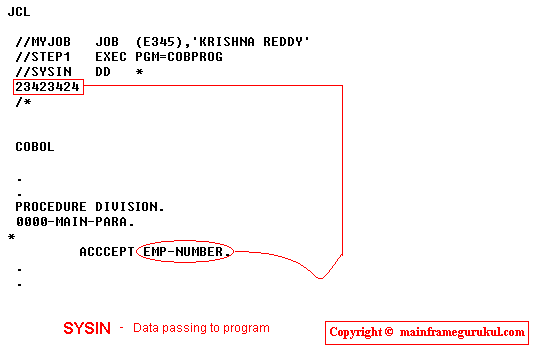| |
SPECIAL DD STATEMENTS
1. DUMMY
DSN=NULLFILE
2. Concatenating Data sets
3. Passing data to cobol program using - SYSIN DD *
4. SYSOUT
5. SYSUDUMP
6. SYSADUMP
1. DUMMY or DSN=NULLFILE
Some times we need to testing of program, without using actual datasets.
Then we can use DUMMY or DSN=NULLFILE.
If we use DUMMY, operating system simulates the presence of a file. When
you reading Operating system sends end of file request to program.
Example JCL --> //MYJOB JOB (W345),'KRISHNA REDDY'
//STEP1 EXEC PGM=COBPROG
//INFILE DD DUMMY
2. CONCATENATING DATA SETS
In JCL , we can concatenate different files by giving their name one after
another. All data sets concated must be of the same type. For example,
partitioned data sets can be concatenated only with partitioned data sets.
Example JCL --> //MYJOB JOB (W345),'KRISHNA REDDY'
//STEP1 EXEC PGM=COBPROG
//INFILE DD DSN=TEST.GLOB.FILE1
// DSN=TEST.GLOB.FILE2
// DSN=TEST.GLOB.FILE3
In program , we will read it as an single file. concatination of three
files done by operating system.
 |
Maximum of 255 sequential data sets can be concatenated together
Maximum of 16 partitioned data sets can be concatenated
together |
|
3. PASS DATA TO COBOL PROGRAM USING - SYSIN DD *
This is the one of the way of passing data to program. There are two
syntax's to pass data.
Syntax1 -> //MYJOB JOB (W234),'RAMESH'
//STEP1 EXEC PGM=COBPROG
//SYSIN DD *
/*
Syntax2 -> //MYJOB JOB (E345),'KRISHNA REDDY'
//STEP1 EXEC PGM=COBPROG
//SYSIN DD DATA
/*
 4. SYSOUT
The SYSOUT parameter is used to send the output which is generated during
job execution.
Syntax -> //ddname DD SYSOUT=class
EXAMPLE JCL -> //MYJOB JOB (R456),'KRISHNA REDDY'
//STEP1 EXEC PGM=COBPROG
//INFILE DD SYSOUT=A
In this example, COBPROG is executed and all generated outputs
are directed to class ( here it is letter A)
4. SYSOUT
The SYSOUT parameter is used to send the output which is generated during
job execution.
Syntax -> //ddname DD SYSOUT=class
EXAMPLE JCL -> //MYJOB JOB (R456),'KRISHNA REDDY'
//STEP1 EXEC PGM=COBPROG
//INFILE DD SYSOUT=A
In this example, COBPROG is executed and all generated outputs
are directed to class ( here it is letter A)
 |
If * used with SYSOUT (SYSOUT=*) parameter, The class
assigned to the MSGCLASS parameter will be used to SYSOUT. |
|
5. SYSUDUMP
SYSUDUMP is used to dump the content of various registers, variables and
datasets acccessed at the time of abnormal termination, into a dataset.
The dump is in hexadecimal.
Syntax --> //SYSUDUMP DD .....
EXAMPLE JCL --> //MYJOB JOB (W345),'RAMESH'
//STEP1 EXEC PGM=COBPROG
//SYSUDUMP DD DSN=TEST.PROD.LIB
6. SYSABEND
SYSABEND is used to dump the contents of various registers variables ,
datasets accessed and The nucleus at the time of abnormal termination.
The dump is in hexadecimal.
Syntax --> //SYSABEND DD .....
EXAMPLE JCL --> //MYJOB JOB (WE345),'KRISHNA REDDY'
//STEP1 EXEC PGM=COBPROG
|
|



